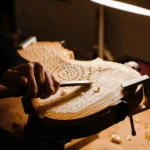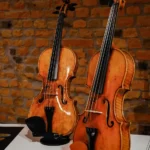What Violin Does Hilary Hahn Play?
Back to BlogMost people have probably heard of the famous violinists who play the violin. But have you ever wondered which violin they play or what’s the story behind it?
With a passion for music, a well-established sound, and a masterful performance, violinists such as Hilary Hahn during their breathtaking concerts, certainly play amazing instruments! Today we put together some curiosities about what violins these great musicians have in their hands, keep scrolling and check out what masterpieces these violinists own.
Hilary Hahn Violin
Violinist Hilary Hahn is a three-time Grammy Award-winning musician who shares her artistic curiosity with a global audience. Hahn is a prolific recording artist and commissioner of new works. She was taking a year-long sabbatical over the 2019-20 concert season; she returned performing after pandemic restrictions were eased up.
“Vuillaume made the violin that Hilary Hahn currently plays in 1865.
Although not an exact copy, it is loosely based on the 1715 ‘Alard’ Stradivari, which was owned by Vuillaume’s son-in-law, Delphin Alard, and was the inspiration for many Vuillaume violins from 1850 onwards. The broad model with strong and flat arching is exactly what made the original Stradivari so popular. At their best, Vuillaume’s Stradivari copies can sound as good as the real McCoy and were then, as they are now, a fair bit more affordable.” Tarisio Auctions
Vuillaume’s workshop made over 3,000 new instruments. Some were made to appear new, but most were either antiqued to appear generically old or made as a copy of a specific instrument.
Itzhak Perlmann Violin
The Israeli-American violinist is known for his brilliant virtuoso technique. His refinement of detail led many to regard him as one of the finest performers of the major violin repertoire of his time. Itzhak owns the 1714 Soil Stradivarius, considered one of Stradivari’s finest violins, the ‘Soil’ (named after a Belgian industrialist) was played by Yehudi Menuhin for the best part of his career before going to Itzhak.
Ray Chen Violin
Born in Taiwan and raised in Australia, Ray was accepted to the Curtis Institute of Music at age 15; there he studied with Aaron Rosand and was supported by Young Concert Artists. Ray Chen is a violinist who redefines what it is to be a classical musician in the 21st century.
He plays the 1715 “Joachim” Stradivarius violin on loan from the Nippon Music Foundation. It was once owned by the famed Hungarian violinist, Joseph Joachim (1831-1907).
Chloe Chua Violin
The rising star 14-year-old Singaporean violinist is an outstanding young artist! Her maturity, musicality, and naturalness are what stand out from the other peers of her age. Impossible not to be amazed by her performances!
She currently performs on a 1729 violin by Peter Guarneri of Venice on a generous loan from The Rin Collection.
Joshua Bell Violin
The incredible violinist plays a 300-year old Stradivarius violin called the ‘Gibson ex Huberman’, handmade during the golden years of the maker.
In an interview to the website Robb Report, Bell told that it almost feels like his own voice, an amazing chemistry that one has with their instrument. This 1713 masterpiece is among Stradivari’s finest, with broad, strong-arched, gorgeously flamed maple back and glorious deep red varnish.
The violin has an interesting story, it has been stolen not once, but twice from its owner Bronisław Huberman. The first time, the Violin was stolen on the musician tour in 1916, in Vienna but it was recovered just days later. The second time, it was during a concert in 1936 when the violinist Bronislaw Huberman was performing at Carnegie Hall. During the second part, the musician changed his Stradivari to a Guarneri, and the instrument was stolen from his dressing room.
No one knows exactly how and why the violin was stolen, but for nearly 50 years the location remained unknown until 1985 when Julian Altman, a New York violinist, made an unpleasant deathbed confession.
Daniel Hope Violin
The British violinist Daniel Hope plays the 1742 “ex-Lipiński” Guarneri del Gesù, placed generously at his disposal by an anonymous family from Germany. The instrument carries the name of its owner, the 19th-century Polish violinist Karol Lipiński, who shared the stage with Paganini, Robert Schumann, and Franz Liszt.
Janine Jansen Violin
Born in Soest, a Dutch town in the province of Utrecht, the musician grow up in a family where music is the heart of her family’s culture. Janine Jansen has worked with the world’s most eminent orchestras and conductors.
Jansen played the 1727 Stradivari “Barrere” violin, on extended loan by the Stradivari Society of Chicago. And nowadays she plays the Shumsky-Rode Stradivarius from 1715, on generous loan by a European benefactor.
Gil Shaham Violin
Mr. Shaham was born in Champaign, Illinois, in 1971. He studied violin with Samuel Bernstein of the Rubin Academy of Music at the age of 7, receiving annual scholarships from the America-Israel Cultural Foundation.
One of the foremost violinists of our time; his flawless technique combined with his inimitable warmth and generosity of spirit has solidified his renown as an American master. He plays the 1699 “Countess Polignac” Stradivarius.
The violin is from 1690 and 1700, a period where Antonio Stradivari was experimenting with a longer shape. The quality of the sound is what stands out to the musician.
Isabelle Faust Violin
She lives in Berlin and is the mother of a teenage son. Since 1996, she has performed on the “Sleeping Beauty” Stradivarius violin of 1704, on loan from Landesbank Baden-Württemberg. She has also performed with Baroque-style violins and bows. In an interview with Strings Magazine, she claims that the instrument’s most enchanting aspect is the sound. She has been playing Sleeping Beauty for two decades now and kindly describes it as a truly human violin.
This violin has also a curious story, although the original label is dated either 1720 or 1729, the instrument is thought to have been made in 1704. The quality of the violin is clear, the perfectly cut f-holes, majestic scroll, and precise purfling are all typical of the golden period. And the wood resembling the ‘Betts’ of 1704 convinces the experts that it must have been made in the same year.
The instrument history is also unclear. It is believed the buyer could have been Baron Franz Wolfgang von Boeselager zu Nehlen, who was traveling in Italy around the year 1724. The most curious fact is that the violin was apparently forgotten for about 150 years in a family attic. Then it was found again, around 1900 by Max’ von Boeselager and his family.









